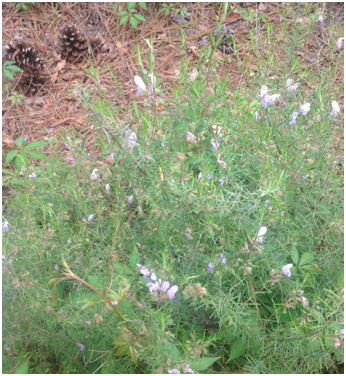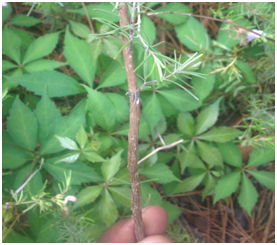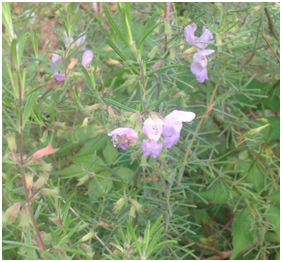Rosemary
Rosmarinus officinalis

(Photo by Nicole Rutledge)
View the Location on Campus
Taxonomy (1)
Classification: Angiosperm, monocot
Family: Lamiaceae/Labiatae
Common name: Rosemary
General Information (1,2)
Region of Origin: Mediterranean
USDA Plants Hardiness Zones: 8-10
Growth Habit: Shrub
- Size: 2-4 feet tall
- Deciduous/Evergreen: Evergreen
Diagnostic Characteristics
Leaves (1)
- Arrangement: Opposite
- Simple/Compound: Simple
- Shape: Needle
- Other: Sessile, revolute margin, fragrant, tomentose lower leaf surface
Stem/Bark

(Photo by Nicole Rutledge)
Flower (1)
- Color: Light blue
- Size: 1/2 inch

(Photo by Nicole Rutledge)
Horticultural Information (1,2,3)
- Light: Full sun
- Soil type: Sandy; poor to moderately fertile; limestone
- Landscape Uses: Against walls or in a pot
- Other: Withstands drought, avoid permanently wet soil, salt tolerant
Interesting Facts (2)
- Rosemary oils are known to have antibacterial properties.
- In ancient Greece students wore it in their hair to improve memory.
- It is said that if a rosemary bush grows vigorously in the garden, the woman is the head of the household.
References
1) Dirr, M. (1998). Manual of woody landscape plants: Their identification, ornamental characteristics, culture, propagation and uses (5th ed.). Champaign, Ill.: Stipes Pub..
2) Christman, Steve. (2004, August 17). Rosemarinus officinalis. Floridata. Retrieved March 31, 2013, from http://www.floridata.com/ref/R/rose_off.cfm
3) Brickell, C., Cole, T. J. (. J., & American Horticultural Society. (2002). American Horticultural Society encyclopedia of plants and flowers (Rev. and updated. ed.). New York: DK Pub..
Edited by Jessica Bartek
Department of Biology
-
Room 2035, 2nd Floor
Bailey Science Building -
Mailing Address
1500 N. Patterson St.
Valdosta, GA 31698 - Phone: 229.333.5759
- Fax: 229.245.6585
Monday - Thursday
8:00AM until 5:30PM
Friday
8:00AM until 3:00PM
Saturday - Sunday
Office Closed